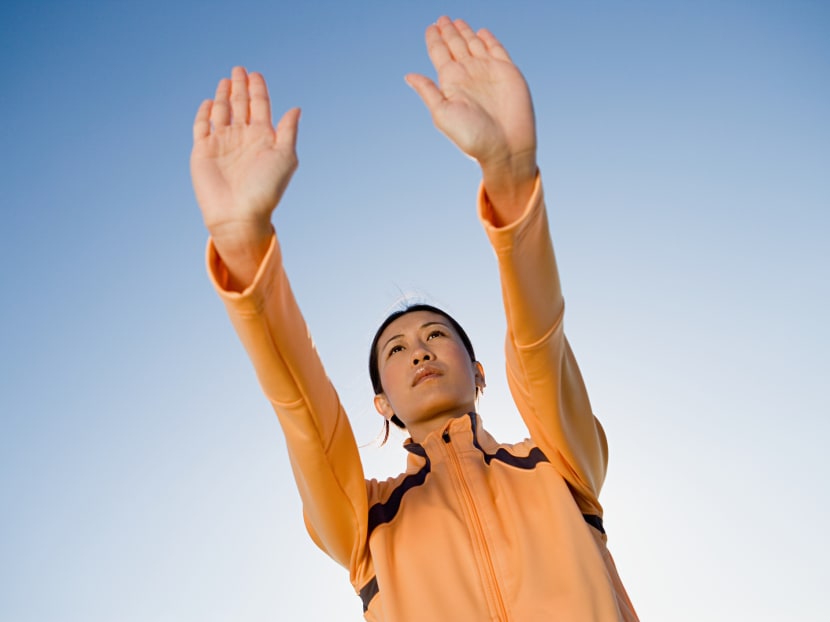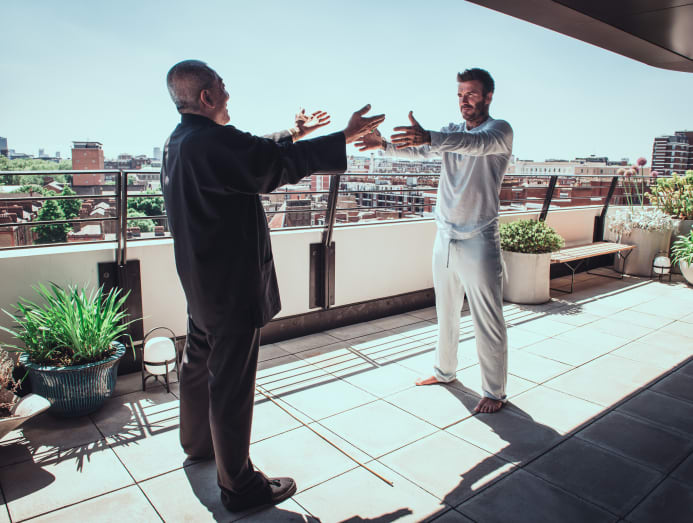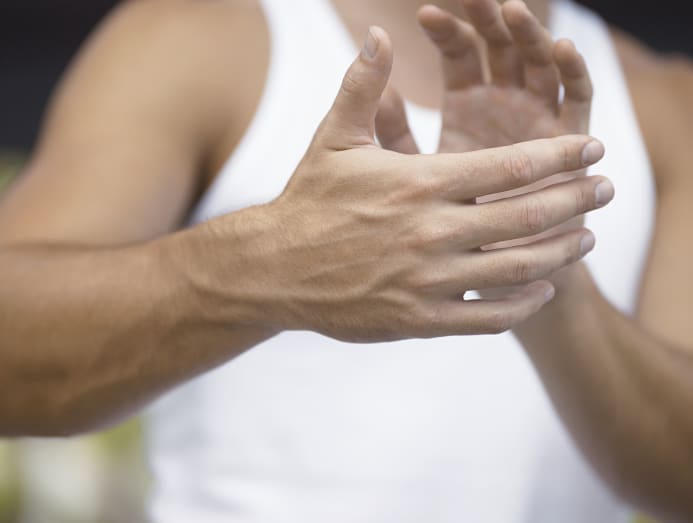How did qigong suddenly become a cool workout for young people?
Yes, it's no longer just for seniors or confined to Chinese clans and wushu associations. The supposedly old-fashioned practice is now embraced by those in their 30s and 20s (even David Beckham gave it a go).

(Photo: iStock/Image Source)
Khoo Bee Khim
25 Oct 2021 07:07AM
(Updated: 25 Oct 2021 07:07AM)
Mention “qigong” and images of grey-haired seniors in loose-fitted samfu (traditional Chinese garb) come to mind for most people.
For me, it’s a reminder of the times watching folks circling their arms in rhythm to pre-recorded instructions playing on a portable cassette player at the neighbourhood basketball court. This was in the 80s when morning qigong sessions got aunties and uncles as excited as Mark Lee in a Shopee commercial.
Fast-forward a few decades later and suddenly, qigong is "in" again. Or at least David Beckham-approved. The football star, who is AIA’s health and wellness ambassador, recently tried taichi (which I was told, can be considered qigong in martial art form) with the guidance of the mysteriously named grand master Tsu.
Over in Singapore, qigong and taichi classes have evolved outside of Chinese clans or wushu associations. Fitness First has a 75-minute taichi class, for instance, while there are private practitioners who offer metaphysical sessions. If it's a community you're after, there are qigong groups on Facebook to join.

David Beckham trying out taichi with grand master Tsu. (Photo: AIA Singapore)
We didn’t have access to grand master Tsu, who appeared with Beckham in a video call. But we got a hold of a local full-time qigong and taichi teacher, Edwin Tan, who led a session as part of AIA Live 2021’s virtual health and wellness events.
And in case you think Tan is a silver-maned, 70-year-old retiree with bushy brows to match, he’s actually a 35-year-old father of two. You’re more likely to find him in a dry-fit T-shirt and sweatpants than a Mandarin-collared top and satin trousers. He is also a qualified personal trainer with a background in judo and Brazilian jujitsu, among other martial art forms.
SAMFU AND AURA NOT NEEDED
“That’s the thing about qigong masters, isn’t it?” said Tan when asked how people react to his appearance and being a qigong teacher at his age.
“They expect the teacher to stand with a certain aura and behave in a certain way and speak fluent Mandarin. But I do whatever is suitable or necessary to help the students understand what the class or session is about.”
Tan has been practising qigong for seven years and teaching it for five years. So is he the youngest qigong and taichi teacher in Singapore?
“When I was practising taichi with a renowned master in his 70s in Toa Payoh, he wanted to pass his knowledge to a young person. But the majority of the people he was teaching were from his age group. The youngest was probably in his late 50s”.
Not that Tan’s students are as old. They range from ages 30s to 50s, and from his stints at Google and LinkedIn, they include those in their 20s as well.
It might seem ironic for this Asian practice to regain popularity here only after it’s seen as “cool” through the western lens. What does Tan think about it? “Some of my students told me that they went one big round of trying Zumba, yoga et cetera before finally getting to qigong. That’s one way to see it.”
For others, they only start to see the value of qigong after they’ve been injured. “Most people are externally driven. As long as the body feels okay, they keep hammering it, let’s do more, let’s get more out of the body,” said Tan.
“It’s only after getting injured or burned out that they start to seek remedy at a deeper level. For some people, they need to go through that approach before they start to see the fit or necessity to take care of the body and mind at a deeper level.”
NO, YOU CAN’T EXPLODE WALLS BUT…
It was time to unlock the mysticism behind those slow (oh, so slow) movements. What do qigong practitioners know that we don’t?
The movements in qigong may appear slow but it's to train your awareness of the different parts of your body, according to Tan. “For example, the feet have to move first, followed by the legs, hips, waist, shoulders, elbows and wrists. If you don’t do it slowly, you’re not in touch with the movement and it just becomes aerobics or the Great Singapore Workout,” he laughed.
Neither is qigong about a specific technique or movement – or acquiring some fantastical prowess. “It’s not about exerting a force and the wall behind you explodes. I always joke with my students in the first class that you don’t expect anything to explode,” he said.
Okay, no explosions then. What about those awe-inspiring feats such as driving a car over a qigong practitioner’s body without crushing him? Or formidable Shaolin monks who can hold a handstand with just their index fingers? Surely, they’re more real than Shang-Chi in the Marvel Cinematic Universe?
They are legit all right and are, in fact, practising a form of martial art qigong known as hard qigong. Martial art qigong also encompasses taichi and Shaolin qigong, said Tan.

(Photo: iStock/Image Source)
Briefly, he explained that qigong can be categorised into the aforementioned martial art qigong as well as health qigong, medical qigong (used in traditional Chinese medicine settings) and oesoteric qigong (for spiritual practices).
If you notice an elderly group practising their moves in the park or open space, it is most likely health qigong that they’re practising, said Tan. And like martial art qigong, health qigong can be further sub-categorised into various degrees of understanding, just like yoga, he said.
QIGONG CAN COMPLEMENT GYM TRAINING
The lean-bodied Tan teaches a mix of health and martial art qigong because of his interest in martial arts as well as his background as a fitness trainer. "I’m bringing qigong in a more grounded way through my background in physical anatomy,” he said.
“Qigong is about body awareness and if you pay attention to using the correct muscles you’re supposed to be using when doing bench presses, for instance, you’ll naturally build those muscles up,” he said. “And let’s be realistic, people want to work on certain muscles because they want to look good in a certain way.”







 Reply With Quote
Reply With Quote